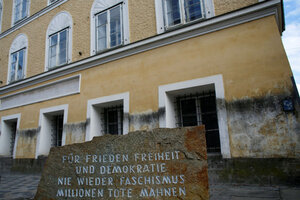Austria to seize, but not destroy, Hitler's house. Here's why it matters.
Austrian officials faced a tough choice about what to do with Hitler's house once legal groundwork was laid for its expropriation.

A stone outside the house in which Adolf Hitler was born, with the inscription 'For peace, freedom and democracy, never again fascism, millions of dead are a warning', is pictured in Braunau am Inn, Austria, Oct. 22, 2016.
Leonhard Foegher/Reuters
The house where Adolf Hitler was born will become property of the state, after the Austrian parliament passed a law on Wednesday that legalizes the house’s expropriation.
The vote brings an effective end to authorities’ longstanding battle with the owner, who refused to sell it. And after a meeting on Thursday between the Austrian interior minister; the provincial governor; and the mayor of Braunau, the town where the residence stands, the three officials announced that the house would be remodeled and given to a charity for people with learning disabilities, according to the BBC.
“After a lengthy meeting we decided not to knock it down after all," said Upper Austria governor Josef Pühringer, according to Agence France-Presse. "A social use, as was the case already over many years, is a life-affirming statement, a homage to the victims of National Socialism and a clear symbol against the crimes committed by Hitler."
The question of what should become of the house had raised tough choices for Austrians, whose understanding of their country’s role in World War II has only in recent decades shifted toward an acknowledgment of involvement in the Third Reich’s crimes. And it seems to underscore the importance of the public's understanding of its country's history and what that means for the present.
The site has been the object of pilgrimages by neo-Nazi groups, to the dismay of locals. And the climate of European politics turning rightward – the far-right populist Freedom Party nearly captured the Austrian presidency in this month’s elections – probably “weighed heavily on the minds of policy-makers” in debates over whether to raze the house or remodel it, says Thomas Berger, a Boston University professor of international relations who has written a book about the role of guilt in post-World War II politics.
“No one expects the Nazis to come back,” he tells The Christian Science Monitor. But there are disturbing similarities between politics of mid 20th-century Europe and the present, he adds. “European political leaders want to remind the general population that Europe stands against it.”
Interior minister Wolfgang Sobotka, one of the three officials who huddled on Thursday, had previously cited a 13-member panel of experts in saying that the house would be torn down, with a new building constructed for use by a charity.
But several panel members pointed out that they hadn’t actually recommended the destruction of the building, issuing a statement in October that equated razing it to “negating Austria’s Nazi past,” according to AFP.
That is a loaded charge in a country where, until the early 1990s, the official story was that Austrians were simply the Nazis’ first victims, obscuring the truth of the way that Austrians received the German takeover, according to Winfried Garscha, a historian at the Documentation Center of Austrian Resistance in Vienna.
“The majority of the Austrian population welcomed Hitler because for them it was a big event, the German chancellor invading Austria and coming here and bringing all those new promises of the Nazis, because Austria at that time was a very poor country,” he told the Australian Broadcasting Corp. in a 2015 interview.
“The second reason was a very Austrian one. In Austria anti-Semitism was even deeper rooted than in Germany. Vienna had a Jewish population of around 11 per cent. And as soon as the German soldiers arrived in Vienna you had an outbreak of the worst anti-Semitic pogroms you ever had seen in central Europe since the Middle Ages.”
A turning point occurred in the early 1990s, during the presidency of Kurt Waldheim, former secretary-general of the United Nations, who lied about his involvement with the Nazi movement and German army as a military-intelligence lieutenant. Revelations of his wartime role were an international scandal.
“It was an important moment for Austrian thinking about the past,” Dr. Berger tells the Monitor. “They became much more forthright in dealing with the past … and came up with a policy of joint responsibility.”
“The Austrian public has come a long way from where it was in the 1980s and 1990s. That self-exculpatory language or thinking, while still there beneath the surface, is not nearly as strong. There’s a deeper sense of penitence and regret and revulsion for Austria’s role.”
It’s unclear to what extent the remodeling and repurposing of the house will discourage pilgrims. In September, the head of the Austrian Nazi Resistance archives, Gerhard Baumgartner, told an Austrian radio station that neo-Nazis might come even if the residence were demolished.
"We must put something there that nobody would want to photograph themselves in front of – a supermarket, a charity store or a fire station," he said, according to Deutsche-Welles.
Berger says he isn’t sure either way. But the handicapped, he notes, had been the Nazis’ first victims.
“A handicapped home? It’s a pretty potent symbol.”

